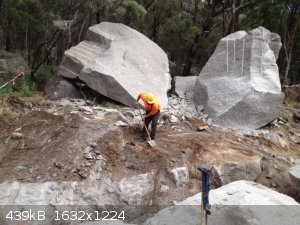curiosity_cat
Harmless

Posts: 36
Registered: 28-6-2017
Member Is Offline
Mood: No Mood
|
|
Non-explosive demolition agents

A slurry mixture of the non-explosive demolition agent and water is poured into the drill holes. Over the next few hours the slurry expands, cracking
the rock in a pattern somewhat like the cracking that would occur from conventional explosives.
Looks like energetic stuff, I would imagine those stones would agree but how does this stuff work ?
I looked all over the online and surprisingly found nothing explaining it or how to possibly make it.
[Edited on 29-6-2017 by curiosity_cat]
|
|
|
MineMan
National Hazard
   
Posts: 996
Registered: 29-3-2015
Member Is Offline
Mood: No Mood
|
|
It is just cement that expands. Its called dexpan. It was a hype for a while.
then there are the autostem products which are energetic
|
|
|
curiosity_cat
Harmless

Posts: 36
Registered: 28-6-2017
Member Is Offline
Mood: No Mood
|
|

Ordinary concrete does not expand, I would guess that if you put this stuff in a steel pipe like they do when making those concrete pipe bollards it
would either stretch or crack it.
[Edited on 29-6-2017 by curiosity_cat]
|
|
|
curiosity_cat
Harmless

Posts: 36
Registered: 28-6-2017
Member Is Offline
Mood: No Mood
|
|
I found these 2 pages
https://www.google.com/patents/US4046583
http://encyclopedia2.thefreedictionary.com/Expansive+Cement
The total expansion ranges between 0.2 and 2 percent; the strength ranges between 30 and 50 meganewtons/m2.
I always thought it would be a fun project to carve a house into stone as long as science did most of the work http://www.popularmechanics.com/home/outdoor-projects/how-to...
|
|
|
Fulmen
International Hazard
    
Posts: 1693
Registered: 24-9-2005
Member Is Offline
Mood: Bored
|
|
http://www.sciencemadness.org/talk/viewthread.php?tid=73463
We're not banging rocks together here. We know how to put a man back together.
|
|
|
PHILOU Zrealone
International Hazard
    
Posts: 2893
Registered: 20-5-2002
Location: Brussel
Member Is Offline
Mood: Bis-diazo-dinitro-hydroquinonic
|
|
Water does it for ages....because water is one of the rare materials that expands when freezing.
Some few metals does it too.
Otherwise most material expands with heat and contract with cooling.
So if you set a cooled material that fits perfectly into the borehole and that you allow it to come at ambiant temperature (or even push it a little
with warm water or fire)...huge pressure are obtained that can break the outer material if its dillatation coefficient is lower than that of the inner
material.
Into hot summer it is not unusual to have street cover material that breaks or bridges that collapse or rail roads that jump out of tracks...
PH Z (PHILOU Zrealone)
"Physic is all what never works; Chemistry is all what stinks and explodes!"-"Life that deadly disease, sexually transmitted."(W.Allen)
|
|
|
curiosity_cat
Harmless

Posts: 36
Registered: 28-6-2017
Member Is Offline
Mood: No Mood
|
|
Studying that one thanks, I remember seeing a liquid nitrogen demonstration as a kid before YouTube existed where they cooled the brass ball then it
fit through the ring, that was impressive.
An idea I had was using a solar to do the tunneling

https://www.youtube.com/watch?v=svAPyyUJUCo
Focus solar on a spot then have a system like in the produce section to periodically spray water to hopefully break off a little. Slow but with solar
tracking and automation I imagine it could do all the work with little input.
[Edited on 29-6-2017 by curiosity_cat]
|
|
|
curiosity_cat
Harmless

Posts: 36
Registered: 28-6-2017
Member Is Offline
Mood: No Mood
|
|
I guess this should continue this over there. Thanks for finding that 
|
|
|
PHILOU Zrealone
International Hazard
    
Posts: 2893
Registered: 20-5-2002
Location: Brussel
Member Is Offline
Mood: Bis-diazo-dinitro-hydroquinonic
|
|
Quote: Originally posted by curiosity_cat  |
Studying that one thanks, I remember seeing a liquid nitrogen demonstration as a kid before YouTube existed where they cooled the brass ball then it
fit through the ring, that was impressive.
An idea I had was using a solar to do the tunneling

https://www.youtube.com/watch?v=svAPyyUJUCo
Focus solar on a spot then have a system like in the produce section to periodically spray water to hopefully break off a little. Slow but with solar
tracking and automation I imagine it could do all the work with little input.
[Edited on 29-6-2017 by curiosity_cat] |
Or simply drive a water flow with sand against the rock...it will pierce and cut through nearly anything upon time ;-)
Solar laser is OK...but not for large chunks...because the focal point is only at a certain distance...so if a hole is made molten material will fill
the cavity.
If the material is somehow porous...the molten material will take less place and fall below the focal point; if the material is dense...the molten
material will remain in place and if not volatilized (volatilization occured into the video example because plaster looses water and SO2 or SO3
leaving CaO behind...but the obsidian glass doesn't)...no hole will form but a cavity with molten liquid that dissipates the heat by convection and by
radiation...in this case no further digging is possible.
Even for the porous case...sooner or later the digging will stop because out of focal point and because the leftover material isn't volatilizable and
moltent to max density...
PH Z (PHILOU Zrealone)
"Physic is all what never works; Chemistry is all what stinks and explodes!"-"Life that deadly disease, sexually transmitted."(W.Allen)
|
|
|
curiosity_cat
Harmless

Posts: 36
Registered: 28-6-2017
Member Is Offline
Mood: No Mood
|
|
I am going to have to get one of those Fresnel lenses because I don't know what happens if its left focused on the same spot for extended periods of
time or what happens to different stones when they have hot spots like that and you spray water on them.
Thankfully its not on Youtube yet where I just watch and be like oh that's what happens.
I am a bone head, I saw a big projection TV out for the trash and did not stop and snag the Fresnel lens, next time I see one I will do it I thought.
That was a year ago, haven't seen one since, they used to be out for the trash all the time but not anymore.
"sooner or later the digging will stop because out of focal point"
Some kind of genie screw drive would need to be created to move it and keep it focused.
Get real good at it and have like a solar rock milling CNC machine.

|
|
|
curiosity_cat
Harmless

Posts: 36
Registered: 28-6-2017
Member Is Offline
Mood: No Mood
|
|
stone laser engraving /cutting machine https://www.youtube.com/watch?v=vQgmdAZDvso
|
|
|
yobbo II
National Hazard
   
Posts: 709
Registered: 28-3-2016
Member Is Offline
Mood: No Mood
|
|
High pressure water cuts rock (and steel).
Could this be done with a diesel pump from a lorry or car.
The modern diesel pumping systems run at around 27,000 psi (twenty seven thousand) I kid you not. The flow rate would be very low which would give a
slow removal rate. You could perhaps connect a few in paralle. They can be had for some dollars in the scrappers yard.
You would have to use some sort of oil (diesel would be a bit messy) as the pump would sieze if used with water.
Yob
|
|
|
curiosity_cat
Harmless

Posts: 36
Registered: 28-6-2017
Member Is Offline
Mood: No Mood
|
|
Quote: Originally posted by yobbo II  |
High pressure water cuts rock (and steel).
Could this be done with a diesel pump from a lorry or car.
The modern diesel pumping systems run at around 27,000 psi (twenty seven thousand) I kid you not. The flow rate would be very low which would give a
slow removal rate. You could perhaps connect a few in paralle. They can be had for some dollars in the scrappers yard.
You would have to use some sort of oil (diesel would be a bit messy) as the pump would sieze if used with water.
Yob |
I like that and if you like diesels check out the Youtube in my new thread A good way of understanding detonation ? http://www.sciencemadness.org/talk/viewthread.php?tid=75110
The diesel documentary.
"as the pump would sieze if used with water"
There must be a way to make water slippery like putting oil in the gas for a 2 stoke.
|
|
|
MineMan
National Hazard
   
Posts: 996
Registered: 29-3-2015
Member Is Offline
Mood: No Mood
|
|
it is just a special kind of expanding concrete look up dexpan
|
|
|
wg48temp9
National Hazard
   
Posts: 761
Registered: 30-12-2018
Location: not so United Kingdom
Member Is Offline
|
|
Several months ago I attempt to make a soluble aluminium acetate by dissolving aluminium in a water acetic acid solution. Initially it produced a
clear solution which then turned to a white gel over several days. I left the gel in its glass jar and forgot about. I needed a solution not a gel.
To day while looking for something else I discovered the gel had hardened and expanded sufficiently to crack the glass in several places. It must
have set sufficiently hard and then expanded to crack the glass in several places because the glass jar was not full.
Perhaps with some tweaking it would make a demolition agent.
I am wg48 but not on my usual pc hence the temp handle.
Thank goodness for Fleming and the fungi.
Old codger' lives matters, wear a mask and help save them.
Be aware of demagoguery, keep your frontal lobes fully engaged.
I don't know who invented mRNA vaccines but they should get a fancy medal and I hope they made a shed load of money from it.
|
|
|
MineMan
National Hazard
   
Posts: 996
Registered: 29-3-2015
Member Is Offline
Mood: No Mood
|
|
Probably. But with aluminum it will be much more expensive then the special concrete
|
|
|